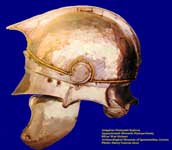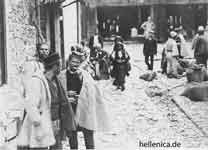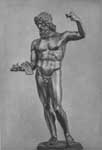.
Paramythia (Greek: Παραμυθιά, Paramythiá) is a village and a former municipality in Thesprotia, Epirus, Greece. Since the 2011 local government reform it is part of the municipality Souli, of which it is the seat and a municipal unit.[1] Population 7,859 (2001).
Name
The name "Paramythia" derives from one of the Virgin Mary's names in Greek ("Paramythia" in Greeks means comforter).[2] During the Byzantine era the town was also known as Agios Donatos (Greek: Άγιος Δονάτος), after Saint Donatus of Evorea,[3][4] the town's patron saint. This is also the basis of the Albanian[5] and the Turkish[CN] name of Paramythia, Ajdhonat, Ajdonat, Ajdonati and Aydonat.
Geography
The Paramythia municipal unit consists of 23 communities. The total population of the municipal unit is 7,859. The town of Paramythia itself has a population of 2,862 and lies in an amphitheatre at an altitude of 750 m, at the foot of Mount Koryla, between the Acheron and the Kalamas rivers. The Koryla range (altitude 1,658 m) lies on the eastern side of the city and the Chionistra (1,644 m) to the Northeast. At the city limits is the Kokytos (Cocytus) River, one of the rivers of the underworld in Greek mythology. Paramythia's valley is one of the largest in Thesprotia Prefecture and is one of the major agricultural areas in Epirus.
|
|
|
|
|
|
|
|
History
Antiquity
The earliest known inhabitants of the area were the Greek tribe of the Chaonians. Paramythia has been identified with the ancient Chaonian city of Photike (Greek: Φωτική), named after Photios, a leader of the Chaonians.[6]

Medieval era
Photike, as with the rest of Epirus, became part of the Roman and subsequently Byzantine Empires. In the late Roman era it was the seat of a Bishopric and was renamed after Saint Donatus of Evorea.
Following the fall of Constantinople to the Fourth Crusade in 1204, Paramythia became part of the Despotate of Epirus. The Despotate remained independent for the next two centuries, maintaining the Greek Byzantine traditions. For a brief period in the 14th century (1358–1367), Paramythia came under the rule of the Albanian chieftain Gjin Bua Shpata, but returned to the Despotate of Epirus by despot Thomas II Preljubović, before falling to the Ottomans in 1449.[7] Paramythia was part of the Ottoman Sanjak of Ioannina.[8][9]
Modern era
The marketplace of Paramythia (1915).
A Greek language school, had been attested since 1682. It declined and close in the mid 18th century,[10] however, another Greek school was continuously operating from the late 17th century and at 1842 was expanded with additional classes.[11] In 1854 a major revolt took place in Epirus and the town came briefly under the control of guerilla Souliote forces that demanded the union of Epirus with Greece.[12]
After the end of the Balkan Wars (1912–1913) the town became part of the Greek state, as with the rest of Epirus periphery. Until the Second World War the town had a mixed population of Greeks and Cham Albanians.[13] During the Greek-Italian War the town was burned by Cham Albanian bands (October 28-November 14, 1940)[14] Almost all buildings inhabited by Muslim Albanians in the town were destroyed during World War II warfare.[15]

Main article: Paramythia executions
On the night of 27 September 1943, Cham militias arrested 53 Greek citizens in Paramythia and executed 49 of them two days later. This action was orchestrated by the brothers Nuri and Mazar Dino (an officer of the Cham militia) in order to get rid of the town's Greek representatives and intellectuals. According to German reports, Cham militias were also part of the firing squad.[16]
During September 20–29, as a result of serial terrorist activities, at least Greek 75 citizens were killed in Paramythia and 19 municipalities were destroyed.[17] On September 30, the Swiss representative of the International Red Cross, Hans-Jakob Bickel, visited the area and concluded:[18]
20,000 Albanians, with Italian and now German support, spread terror to the rest of the population. Only in the region of Fanari 24 villages were destroyed. The entire harvest was taken by them. In my trip I realized that the Albanians kept the Greeks terrified inside their homes. Young Albanians, just finished from school, wandered heavily armed. The Greek population of Igoumenitsa had to find refuge in the mountains. The Albanians had stolen all the cattle and the fields remain uncultivated.
Notable inhabitants
Sotirios Voulgaris, the notable Greek [19] who founded the jewelry and luxury goods company Bulgari. His jewelry store in Paramythia survives. Following his wish, his sons funded the building of the elementary school of the town.
Dionysius the Philosopher (1560–1611), Greek monk and revolutionary.
Alexios Pallis (1803–1885), Greek writer.
Subdivisions
Division of the municipality
- Paramythia / Τ.δ. Παραμυθιάς [ 2862 ]
- Agia Kyriaki / Τ.δ. Αγίας Κυριακής -- η Αγία Κυριακή [ 46 ]
- Ampelia / Τ.δ. Αμπελιάς [ 244 ]
- Grika / Τ.δ. Γκρίκας -- η Γκρίκα [ 243 ]
- Elataria / Τ.δ. Ελαταριάς -- η Ελαταριά [ 19 ]
- Zervochorion / Τ.δ. Ζερβοχωρίου [ 510 ]
- Zervochorion / το Ζερβοχώριον [ 166 ]
- Asfaka / η Ασφάκα [ 29 ]
- Kaminion / το Καμίνιον [ 315 ]
- Zervochorion / το Ζερβοχώριον [ 166 ]
- Kallithea Souliou / Τ.δ. Καλλιθέας Σουλίου [ 203 ]
- Kallithea / η Καλλιθέα [ 96 ]
- Avaritsa / η Αβαρίτσα [ 56 ]
- Vrysopoula / η Βρυσοπούλα [ 51 ]
- Kallithea / η Καλλιθέα [ 96 ]
- Karvounarion / Τ.δ. Καρβουναρίου [ 527 ]
- Karvounarion / το Καρβουνάριον [ 427 ]
- Kyra Panagia / η Κυρά Παναγιά [ 100 ]
- Karvounarion / το Καρβουνάριον [ 427 ]
- Kariotion / Τ.δ. Καριωτίου -- το Καριώτιον [ 321 ]
- Krystallopigi / Τ.δ. Κρυσταλλοπηγής [ 400 ]
- Kefalovryson / το Κεφαλόβρυσον [ 220 ]
- Krystallopigi / η Κρυσταλλοπηγή [ 180 ]
- Kefalovryson / το Κεφαλόβρυσον [ 220 ]
- Neochorion / Τ.δ. Νεοχωρίου [ 488 ]
- Neochorion / το Νεοχώριον [ 169 ]
- Agios Georgios / ο Άγιος Γεώργιος (Τ.δ. Νεοχωρίου) [ 28 ]
- Neraida / η Νεράιδα [ 291 ]
- Neochorion / το Νεοχώριον [ 169 ]
- Xirolofos / Τ.δ. Ξηρολόφου [ 308 ]
- Pagkrates / Τ.δ. Παγκρατών (Παγκρατίου) -- οι Παγκράτες (τ. Παγκράτι) [ 175 ]
- Pente Ekklisies / Τ.δ. Πέντε Εκκλησιών -- οι Πέντε Εκκλησιές [ 102 ]
- Petousion / Τ.δ. Πετουσίου -- το Πετούσιον [ 66 ]
- Petrovitsa / Τ.δ. Πετροβίτσας -- η Πετροβίτσα [ 69 ]
- Plakoti / Τ.δ. Πλακωτής -- η Πλακωτή [ 145 ]
- Polydroson / Τ.δ. Πολυδρόσου -- το Πολύδροσον [ 127 ]
- Prodromion / Τ.δ. Προδρομίου [ 421 ]
- Prodromion / το Προδρόμιον [ 129 ]
- Dafnoula / η Δαφνούλα [ 292 ]
- Prodromion / το Προδρόμιον [ 129 ]
- Saloniki / Τ.δ. Σαλονίκης -- η Σαλονίκη [ 73 ]
- Sevaston / Τ.δ. Σεβαστού -- το Σεβαστόν [ 146 ]
- Chrysaugi / Τ.δ. Χρυσαυγής -- η Χρυσαυγή [ 169 ]
- Psaka / Τ.δ. Ψάκας [ 195 ]
- Psaka / η Ψάκα [ 184 ]
- Nounesation / το Νουνεσάτιον [ 11 ]
- Psaka / η Ψάκα [ 184 ]
Polydroso

Polydroso (or Polydroson), older name Vlachori, is a village of Paramythia. Various churches are in or outside the village. The church of Agios Dimitrios in the center of the village is from the year 1577. Since 1971 the village has a folklore museum.
See also
List of cities in ancient Epirus
Axis-Cham Albanian collaboration
Paramythia executions
References
^ Kallikratis law Greece Ministry of Interior (Greek)
^ paramythia.gr
^ Elsie, Robert (2000). "The Christian Saints of Albania". Balkanistica13 (American Association for South Slavic Studies): 36.
^ Epirus, 4000 years of Greek history and civilization M. V. Sakellariou. Ekdotike Athenon, 1997. ISBN 9789602133712, p. 183 "modern Paramythia bore the Saint's name for many centuries..." (ca. from 7th to 15th cent.)
^ Duka, Ferit; Society and Economy in Ottoman Çameria: Kazas of Ajdonat and Mazrak (Second Half of the 16th Century) p.3, periodic Historical Studies (Studime historike) issue: 34 / 2004
^ An Inventory of Archaic and Classical Poleis: An Investigation Conducted by The Copenhagen Polis Centre for the Danish National Research Foundation by Mogens Herman Hansen, 2005, page 340.
^ Epirus, 4000 years of Greek history and civilization M. V. Sakellariou. Ekdotike Athenon, 1997. ISBN 9789602133712, p. 212-219.
^ H. Karpat, Kemal (1985). Ottoman population, 1830-1914: demographic and social characteristics. p. 146. Retrieved 22 September 2011.
^ Motika, Raoul (1995). Türkische Wirtschafts- und Sozialgeschichte (1071-1920). p. 297. Retrieved 22 September 2011. "Sancaks Yanya (Kazas: Yanya, Aydonat (Paramythia), Filat (Philiates), Meçova (Metsovo), Leskovik (war kurzzeitig Sancak) und Koniçe (Konitsa)"
^ "Σχολή Παραμυθίας. [School of Paramythia"] (in Greek). Κάτοπρον Ελληνικής Επιστήμης και Φιλοσοφίας (University of Athens). Retrieved 2010-10-30.
^ Sakellariou, M. V. (1997). Epirus, 4000 years of Greek history and civilization. Ekdotike Athenon. p. 306. ISBN 9789602133712.
^ M. V. Sakellariou. Epirus, 4000 years of Greek history and civilization. Ekdotike Athenon, 1997. ISBN 9789602133712, p. 288
^ Meyer 2008: 464
^ Georgia Kretsi. Verfolgung und Gedächtnis in Albanien: eine Analyse postsozialistischer Erinnerungsstrategien. Harrassowitz, 2007. ISBN 9783447055444, p. 283.
^ Kiel, Machiel (1990). Ottoman architecture in Albania, 1385-1912. Research Centre for Islamic History, Art and Culture. p. 3. ISBN 9789290633303. Retrieved 1 November 2010.
^ Meyer 2008: 469-471
^ Meyer 2008: 476
^ Meyer 2008: 498
^ Bulgari.html
Sources
Meyer, Hermann Frank (2008) (in German). Blutiges Edelweiß: Die 1. Gebirgs-division im zweiten Weltkrieg [Bloodstained Edelweiss. The 1st Mountain-Division in WWII]. Ch. Links Verlag. ISBN 9783861534471. http://books.google.com/books?id=_Hpr-PK39UkC&dq=.
| Ancient Greece
Science, Technology , Medicine , Warfare, , Biographies , Life , Cities/Places/Maps , Arts , Literature , Philosophy ,Olympics, Mythology , History , Images Medieval Greece / Byzantine Empire Science, Technology, Arts, , Warfare , Literature, Biographies, Icons, History Modern Greece Cities, Islands, Regions, Fauna/Flora ,Biographies , History , Warfare, Science/Technology, Literature, Music , Arts , Film/Actors , Sport , Fashion --- |
Retrieved from "http://en.wikipedia.org/"
All text is available under the terms of the GNU Free Documentation License







